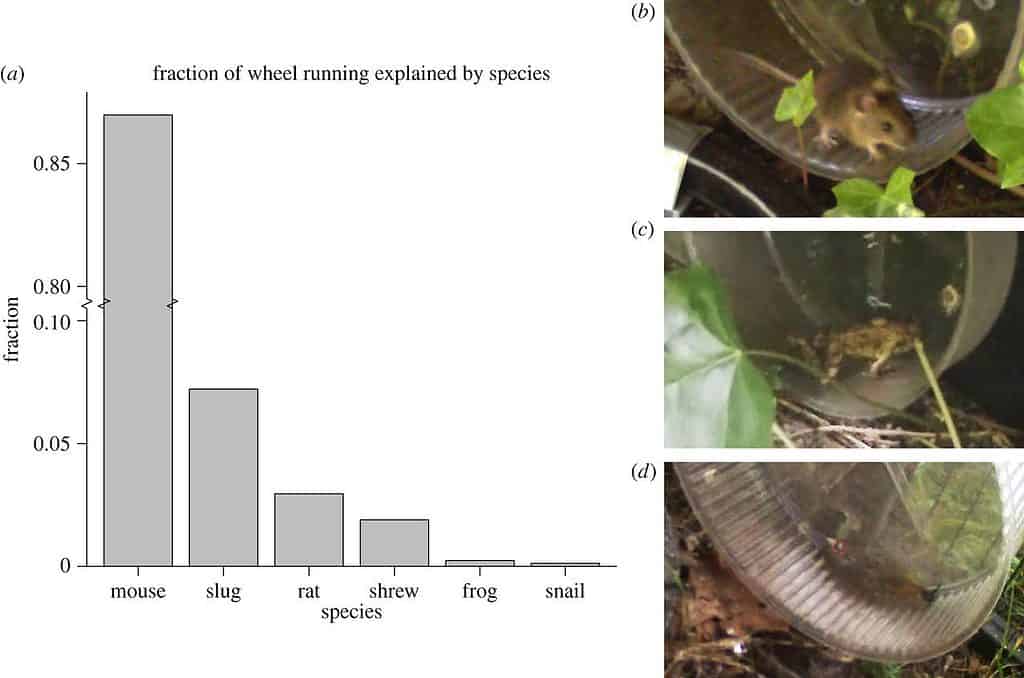In 2014, a team of Dutch scientists set out to conduct an unusual experiment. They placed a hamster wheel in the wild to see whether mice would use it as they do in captivity. Not only did the wild mice play with the wheel, but frogs, rats, shrews, and even slugs also interacted with it—suggesting that running on wheels might fulfill an innate desire to play rather than being just a captive behavior.
This simple yet groundbreaking study challenges the long-standing belief that wheel running is an artificial behavior, confined to animals in captivity. It raises intriguing questions about the motivations behind animal play, curiosity, and physical activity in the wild.
Wheel running in the wild
For pet and lab mice, running wheels are a common feature, often used to encourage exercise. However, some scientists have argued that mice only run on these wheels because they live in cages and that they wouldn’t engage in this behavior if given the choice in their natural habitat.
But until 2014, no one had actually tested this assumption—until Johanna Meijer and Yuri Robbers from Leiden University decided to conduct an experiment.
“If wheel running is indeed caused by captive housing, wild mice are not expected to use a running wheel in nature. This, however, to our knowledge, has never been tested. Here, we show that when running wheels are placed in nature, they are frequently used by wild mice,” the researchers explained in the study.
To investigate, the scientists set up a running wheel in a backyard and installed an infrared camera to film how animals would respond. The wheel was enclosed within a small structure with an entrance designed to allow small animals inside while keeping them safe from larger predators. To attract wildlife, they initially placed food near the wheel, but they later removed it to see if animals would still use it.
The results were fascinating: all sorts of animals started interacting with the wheel. While mice were the most enthusiastic users, shrews, rats, and frogs also engaged with it. Frogs would occasionally trigger the wheel by jumping, and slugs seemed more interested in exploring the surface rather than running—but the other animals, especially the mice, actively used it for prolonged periods.

The results were so encouraging that researchers set up another wheel and camera in a nearby dune area that was not available to the general public. This second wheel was left in place for a year and a half.
Remarkably, the animals kept gathering at the wheel. Over a span of three years, the team recorded over 200,000 animal visits and analyzed more than 12,000 video clips of animals interacting with the wheels. Some individuals showed remarkably consistent behavior—one mouse ran for an astonishing 18 minutes!
When the food was taken away from the wheel, the number of visits dropped significantly but still didn’t decrease to zero. Also, some mice using the wheel were observed to be too young to have known that there was ever a food reward; in other words, they were just using the wheel for the sake of it.
This begs the question of why animals run in wheels when there’s no reward. Researchers propose one idea that could be linked to the metabolic reward system: it’s a motor response to hunger or other stimuli related to foraging. It could also satisfy the animals’ curiosity or desire to play. This idea is backed by the fact that when the food was taken away from the wheel, fewer animals showed up — but those that did show up were more likely to use it.
“Our results indicate that while the number of visits to the recording site decreased when no food was present, the fraction of visits including wheel running increased. This implies that wheel running can be experienced as rewarding even without an associated food reward,” the researchers write.
Why do mice run on wheels?

This experiment opens up a major question: why do animals engage in wheel running when there’s no clear reward?
One theory suggests that it may be linked to a metabolic reward system, where movement provides a natural stimulus related to foraging or hunger. Another possibility is that it satisfies a fundamental instinct to play or explore new objects in their environment.
Interestingly, the study also found seasonal variations in wheel use. Mice were more likely to run during the warmer months, with peaks in late spring and summer. This coincides with the time when young mice are most active, possibly indicating that juveniles are more curious or energetic.
It’s likely that there’s more than just one motivation at play, but whatever the case may be, one thing is for sure: mice don’t just use the wheel in captivity, they also use it in the wild. So this is feeding a natural desire for them, not creating an artificial need. This could have implications both for people keeping mice as pets, and for researchers using lab mice.
Journal Reference: Wheel running in the wild, Published 21 May 2014 DOI: 10.1098/rspb.2014.0210
This article was originally published in January 2023 and has been since reedited to add more information.






